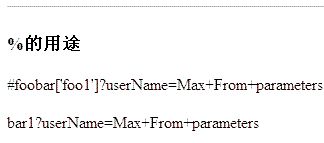OGNL的用法
OGNL是通常要结合Struts 2的标志一起使用,如<s:property value="xx" />等。大家经常遇到的问题是#、%和$这三个符号的使用。下面我想通过例子讲述这个问题:
首先新建名为Struts2_OGNL的Web工程,配置开发环境。之前很多朋友在使用Struts 2的过程中都遇到乱码问题。当然乱码问题由来已久,而且涉及多方面的知识,所以并非三言两语可以说明白,而且互联网上也已经有很多这方便的文章,大家可以Google一下。不过,如果你在开发的过程,多注意一下,避免乱码问题也不难。乱码多数是由于编码与解码所使用的方式不同造成的,所以我建议大家将编码方式都设为“utf-8”,如<%@ page language="java" contentType="text/html; charset=utf-8" pageEncoding="utf-8" %>。另外,在配置web.xml时使用ActionContextCleanUp过滤器(Filter),如下面代码所示:
清单1 WebContent/WEB-INF/web.xml
<?xml version="1.0" encoding="UTF-8"?>
<web-app id="WebApp_9" version="2.4"
xmlns="http://java.sun.com/xml/ns/j2ee"
xmlns:xsi="http://www.w3.org/2001/XMLSchema-instance"
xsi:schemaLocation="http://java.sun.com/xml/ns/j2ee http://java.sun.com/xml/ns/j2ee/web-app_2_4.xsd">
<display-name>Struts 2 OGNL</display-name>
<filter>
<filter-name>struts-cleanup</filter-name>
<filter-class>
org.apache.struts2.dispatcher.ActionContextCleanUp
</filter-class>
</filter>
<filter-mapping>
<filter-name>struts-cleanup</filter-name>
<url-pattern>/*</url-pattern>
</filter-mapping>
<filter>
<filter-name>struts2</filter-name>
<filter-class>
org.apache.struts2.dispatcher.FilterDispatcher
</filter-class>
</filter>
<filter-mapping>
<filter-name>struts2</filter-name>
<url-pattern>/*</url-pattern>
</filter-mapping>
<welcome-file-list>
<welcome-file>index.html</welcome-file>
</welcome-file-list>
</web-app>
“#”主要有三种用途:
1. 访问OGNL上下文和Action上下文,#相当于ActionContext.getContext();下表有几个ActionContext中有用的属性:
| 名称 |
作用 |
例子 |
| parameters |
包含当前HTTP请求参数的Map |
#parameters.id[0]作用相当于request.getParameter("id") |
| request |
包含当前HttpServletRequest的属性(attribute)的Map |
#request.userName相当于request.getAttribute("userName") |
| session |
包含当前HttpSession的属性(attribute)的Map |
#session.userName相当于session.getAttribute("userName") |
| application |
包含当前应用的ServletContext的属性(attribute)的Map |
#application.userName相当于application.getAttribute("userName") |
| attr |
用于按request > session > application顺序访问其属性(attribute) |
#attr.userName相当于按顺序在以上三个范围(scope)内读取userName属性,直到找到为止 |
2. 用于过滤和投影(projecting)集合,如books.{?#this.price<100};
3. 构造Map,如#{'foo1':'bar1', 'foo2':'bar2'}。
下面让我们它们的具体写法,首先是Action类代码:
清单2 src/tutorial/action/OgnlAction.java
package tutorial.action;
import java.util.LinkedList;
import java.util.List;
import java.util.Map;
import javax.servlet.ServletContext;
import javax.servlet.http.HttpServletRequest;
import org.apache.struts2.interceptor.ServletRequestAware;
import org.apache.struts2.interceptor.SessionAware;
import org.apache.struts2.util.ServletContextAware;
import tutorial.model.Book;
import com.opensymphony.xwork2.ActionSupport;
public class OgnlAction extends ActionSupport implements ServletRequestAware, SessionAware, ServletContextAware {
private static final long serialVersionUID = 1L;
private HttpServletRequest request;
private Map<String, String> session;
private ServletContext application;
private List<Book> books;
public void setServletRequest(HttpServletRequest request) {
this.request = request;
}
@SuppressWarnings("unchecked")
public void setSession(Map session) {
this.session = session;
}
public void setServletContext(ServletContext application) {
this.application = application;
}
public List<Book> getBooks() {
return books;
}
@Override
public String execute() {
request.setAttribute("userName", "Max From request");
session.put("userName", "Max From session");
application.setAttribute("userName", "Max From application");
books = new LinkedList<Book>();
books.add(new Book("978-0735619678", "Code Complete, Second Edition", 32.99));
books.add(new Book("978-0596007867", "The Art of Project Management", 35.96));
books.add(new Book("978-0201633610", "Design Patterns: Elements of Reusable Object-Oriented Software", 43.19));
books.add(new Book("978-0596527341", "Information Architecture for the World Wide Web: Designing Large-Scale Web Sites", 25.19));
books.add(new Book("978-0735605350", "Software Estimation: Demystifying the Black Art", 25.19));
return SUCCESS;
}
}
清单3 WebContent/Ognl.jsp
以上代码分别在request、session和application的范围内添加“userName”属性,然后再在JSP页面使用OGNL将其取回。我还创建了Book对象的列表用于演示“用于过滤和投影(projecting)集合”的功能,至于Book的代码大家可以在我前一文章《在Struts 2中实现CRUD》看到。
下面是Ognl.jsp的代码,内容如下:
<%@ page language="java" contentType="text/html; charset=utf-8" pageEncoding="utf-8" %>
<%@ taglib prefix="s" uri="/struts-tags" %>
<!DOCTYPE html PUBLIC "-//W3C//DTD XHTML 1.0 Transitional//EN" "http://www.w3.org/TR/xhtml1/DTD/xhtml1-transitional.dtd">
<html xmlns="http://www.w3.org/1999/xhtml">
<head>
<title>Struts OGNL Demo</title>
</head>
<body>
<h3>访问OGNL上下文和Action上下文</h3>
<p>parameters: <s:property value="#parameters.userName" /></p>
<p>request.userName: <s:property value="#request.userName" /> </p>
<p>session.userName: <s:property value="#session.userName" /> </p>
<p>application.userName: <s:property value="#application.userName" /> </p>
<p>attr.userName: <s:property value="#attr.userName" /> </p>
<hr />
<h3>用于过滤和投影(projecting)集合</h3>
<p>Books more than $35</p>
<ul>
<s:iterator value="books.{?#this.price > 35}">
<li><s:property value="title" /> - $<s:property value="price" /></li>
</s:iterator>
</ul>
<p>The price of "Code Complete, Second Edition" is:
<s:property value="books.{?#this.title=='Code Complete, Second Edition'}.{price}[0]"/></p>
<hr />
<h3>构造Map</h3>
<s:set name="foobar" value="#{'foo1':'bar1', 'foo2':'bar2'}" />
<p>The value of key "foo1" is <s:property value="#foobar['foo1']" /></p>
</body>
</html>
清单4 src/struts.xml
以上代码值得注意的是“<s:property value="books.{?#this.title=='Code Complete, Second Edition'}.{price}[0]"/>”,因为“books.{?#this.title=='Code Complete, Second Edition'}.{price}”返回的值是集合类型,所以要用“[索引]”来访问其值。
最后是Struts 2的配置文件struts.xml,内容如下:
<?xml version="1.0" encoding="UTF-8"?>
<!DOCTYPE struts PUBLIC
"-//Apache Software Foundation//DTD Struts Configuration 2.0//EN"
"http://struts.apache.org/dtds/struts-2.0.dtd">
<struts>
<constant name="struts.devMode" value="true" />
<package name="Struts2_OGNL_DEMO" extends="struts-default">
<action name="Ognl" class="tutorial.action.OgnlAction">
<result>/Ognl.jsp</result>
</action>
</package>
</struts>
清单5 示例运行结果1
发布运行应用程序,结果如下所示:
清单6 演示%用途的代码片段
“%”符号的用途是在标志的属性为字符串类型时,计算OGNL表达式的值。例如在Ognl.jsp中加入以下代码:
<hr />
<h3>%的用途</h3>
<p><s:url value="#foobar['foo1']" /></p>
<p><s:url value="%{#foobar['foo1']}" /></p>
清单7 示例运行结果2
刷新页面,结果如下所示:

清单8 演示$用途的代码片段
“$”有两个主要的用途
1. 用于在国际化资源文件中,引用OGNL表达式,例子请参考《在Struts 2.0中国际化(i18n)您的应用程序》
2. 在Struts 2配置文件中,引用OGNL表达式,如
<action name="AddPhoto" class="addPhoto">
<interceptor-ref name="fileUploadStack" />
<result type="redirect">ListPhotos.action?albumId=${albumId}</result>
</action>
清单9 src/bean/Book.java
public class Book {
private String isbn;
private String title;
private double price;
public Book(String isbn, String title, double price) {
super();
this.isbn = isbn;
this.price = price;
this.title = title;
}
public String getIsbn() {
return isbn;
}
public void setIsbn(String isbn) {
this.isbn = isbn;
}
public String getTitle() {
return title;
}
public void setTitle(String title) {
this.title = title;
}
public double getPrice() {
return price;
}
public void setPrice(double price) {
this.price = price;
}
}
总结
OGNL是一种功能很大的表达式语言,熟悉它可以使我们的开发变得更快捷。
